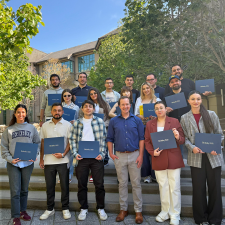As part of the “Church and Law” interview series, Iravaban.net talked with Father Mesrop Hmayakyan, the spiritual shepherd of the Kecharis Monastic Complex in the Kotayk Diocese, at the Holy Mother of God Church in Meghradzor on the topic of “Religious symbols in public spaces: Legal, social, and spiritual aspects.”
– We have the awareness that every corner of Armenia is a holy place. How appropriate is it to place crosses and various religious symbols in every corner?
– A question may arise as to why the historian says that the land of Armenia is holy. Is it because there are chapels, khachkars (cross-stones), churches at every step, or did the historians see a different meaning? The answer to this question is that people have lived with the consciousness and feeling of holiness. Of course, khachkars, chapels, and churches remind us of holiness, but the circumstance lies in the reality of how much these memories of holiness can penetrate into a person. People, carrying holiness within themselves, place khachkars or build holy places. These become meeting places where a person should come to rediscover God.
– Is the placement of any religious symbol – a cross or other sacred image – in public spaces coordinated with the church, and who has the authority to permit or prohibit their placement?
– Usually, they should inform the diocesan leaders, and after appropriate orders, inform the community leader. If there are no objections, I think there won’t be a problem.
– How are religious symbols in public spaces perceived by the public?
– Our church is iconophile. There were discussions in the 7th century, and it was decided that our church respects images, and we accept what is depicted in the image. Even clergymen give an example, saying that when we kiss an image, we’re not kissing the image itself, but what is depicted in the image. A person can express their religious feelings in different ways. If images contribute to the development of the inner person, then it’s positive. However, sometimes an image can be used in an inappropriate place and with an inappropriate meaning.
– Are places where crosses are placed considered holy sites?
– These crosses can become reminders for a person to start thinking about holiness and become the force that leads a person towards holiness. If there needs to be a khachkar or a chapel, and garbage is thrown next to it, then in this sense it’s unacceptable. People’s attitudes are also unacceptable. If a person lives by spiritual values, they won’t throw garbage not only near holy places but anywhere, because if garbage resides inside a person’s heart, it’s also expressed outside of it.
– How has society’s attitude towards religious symbols changed over the past decades, and what factors have influenced these changes?
– Crosses, khachkars, chapels, churches… day by day, they are increasingly valued by our people. It’s not that there are no problems; we don’t want to look at our society through rose-colored glasses, but the fact that people, as much as possible, try to live by spiritual principles is evident. If good is at work, it doesn’t mean that evil isn’t at work.
Details are in the video.
Hasmik Sargsyan
































